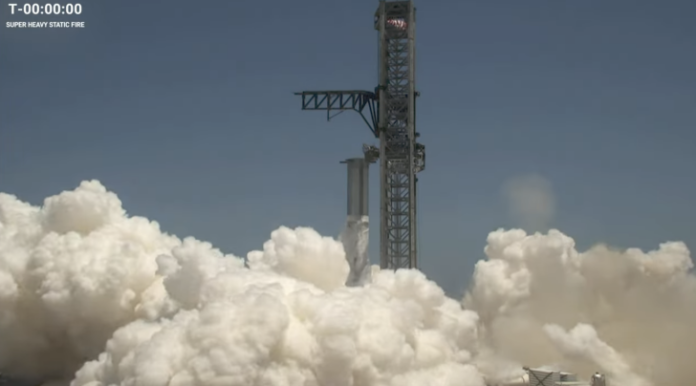
After it kicked off September with a flurry of launches and an astronaut landing, SpaceX is busy moving towards its next Starship test flight. The firm has successfully stacked the second stage of the Starship rocket on top of its first stage, and all eyes are on Boca Chica, Texas as the firm races to the next Starship test. SpaceX has already conducted crucial static fire tests of the Starship Super Heavy booster, leaving a handful of tests before the rocket can light up dozens of its engines and attempt to reach orbit.
SpaceX Stacks Starship Spacecraft On Super Heavy Booster As Part Of Test Flight Campaign
Developing the Super Heavy booster is a major part of the Starship test campaign, and so far, SpaceX has been busy ironing out the kinks in the rocket. One of the toughest problems in Starship development is lighting up the 33 rocket engines at the same time, and SpaceX's latest static fire test saw 31 engines sustain ignition. The first test flight in April was also noticeable when some of its engines malfunctioned during flight. However, despite this, the rocket was able to successfully fly to the point of stage separation before its self destruct systems were activated.
The second Starship test flight will be crucial as it will be te first time when SpaceX will test a hot stage separation mechanism. This involves lighting up the second stage's engines while it still connected to the first stage booster and for this portion of the flight, SpaceX has installed a venting ring on top of the Super Heavy booster. Starship's second stage which was stacked on Super Heavy booster 9 earlier today was placed on top of this ring. This allowed SpaceX to verify the newest addition to the Starship rocket, and workers continued to work at this area after the rockets were stacked on top of each other.

Visuals of the stacking were captured by dedicated onlookers, with footage showing the second stage Starship being lifted up by SpaceX's massive chopsticks at the launch tower for final integration into the Starship stack. Unlike SpaceX's Falcon 9 and Falcon Heavy rockets, which are assembled for launch horizontally, Starship uses chopsticks to place the ship on the booster. These chopsticks are also crucial for the rocket's reusability, as they are designed to 'catch' the first stage booster after it returns to Earth and then quickly prepare it for another launch.
A Starship stacking is not an indicator of an impending test flight, as it is possible that SpaceX decides to de-stack the rockets for further work. However, the crucial static fire tests are finished, indicating that perhaps SpaceX has to conduct a wet dress rehearsal of the full stack before it feels comfortable for the second flight test.
So far, the company has not provided official confirmation of the stacking, so it is unclear what the objectives are. SpaceX still has to receive approval from the FAA for the test flight as it convinces the regulator that any systems that pose a hazard to either humans or the environemtn during the first test flight have been upgraded for the second test.
Ship 25 has been stacked atop Booster 9, the first time a ship and booster combined with the vented interstage have been assembled together. Both of these are available as metal prints:https://t.co/oIphVCDjEHhttps://t.co/OLhE7PtNlu
Watch live here: https://t.co/PAl89OwRBo pic.twitter.com/HRz5OQJ2sJ
— Jack Beyer (@thejackbeyer) September 5, 2023
WccftechContinue reading/original-link]




